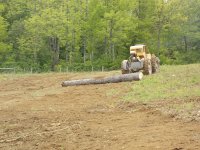It definitely comes down to the length of the dips and bumps and whether or not the grader implement can span them. And then the angle of attack of the cutting edge(s) and the amount of material collected and able to be redistributed.
My box blade is only about 2' long so when it's floating it has limited ability to fill in long low spots, but if I have the rear cutting edge feathered going into the low spot, the box will start distributing material and then the rear edge will start riding on the new material while more is distributed out the front. It's a delicate balance and having a hydraulic top link is the key, as I can make realtime adjustments from the seat to keep the box doing what I want. It all reinforces my notion that the box blade is a very versatile but very imperfect tool. To do a good job grading with it, you have to really stay on top of the adjustments. A long dedicated grader implement eliminates all the fussiness of the box, but of course it's not as versatile for other stuff.
If I had more space to store implements, I'd for sure buy or build a grader or land plane (longer lower box with multiple edges). My road is at the point where a grader would be more appropriate now. As time goes on, I have fewer and fewer dedicated uses for my box blade, but of course word has got out and I do a lot of work for neighbors with it, mostly final grading around new homes/barns. It's such a good tool for that. This is one of the rare cases where I think a smaller tractor would be even better.

